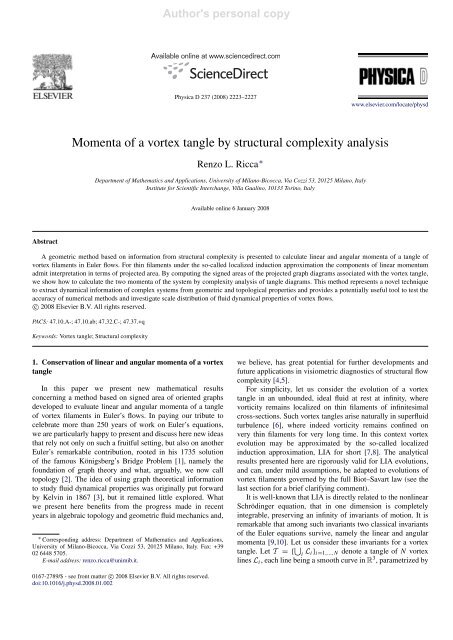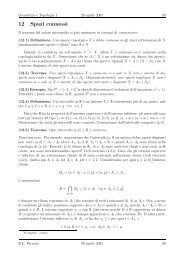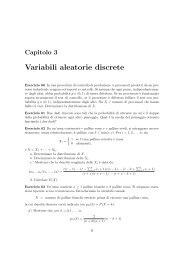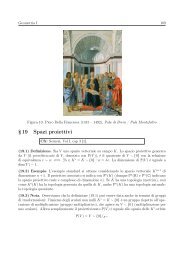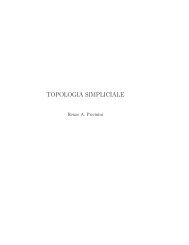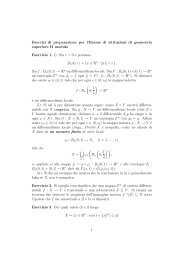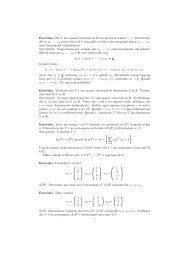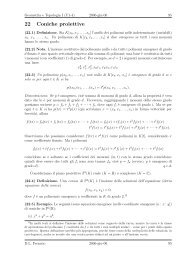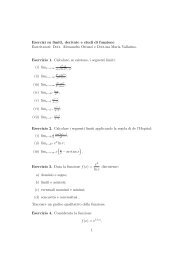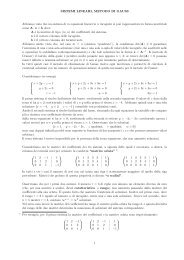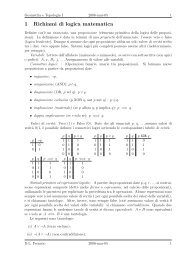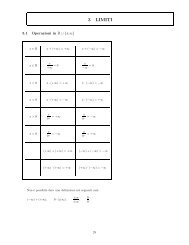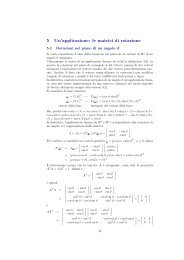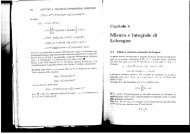Momenta of a vortex tangle by structural complexity analysis
Momenta of a vortex tangle by structural complexity analysis
Momenta of a vortex tangle by structural complexity analysis
Create successful ePaper yourself
Turn your PDF publications into a flip-book with our unique Google optimized e-Paper software.
Author's personal copy2224 R.L. Ricca / Physica D 237 (2008) 2223–2227Fig. 1. The area A <strong>of</strong> the projected graph resulting from the projection p ν <strong>of</strong>a <strong>vortex</strong> line L on the plane Π is proportional to the component <strong>of</strong> the linearmomentum <strong>of</strong> L in the ν-direction.arc-length s. Vorticity ω is defined on L i , and is simply given <strong>by</strong>ω = ¯ωX ′ , where, in general, X = X(s, t) denotes the positionvector, ¯ω a constant and t ≡ X ′ the unit tangent to L i (the primedenoting the derivative with respect to s, and t is time). Thelinear momentum P = P(T ) corresponds to the hydrodynamicimpulse, which generates the motion <strong>of</strong> T from rest, and fromits standard definition [11] takes the formP = 1 ∫X × ωd 3 X = 1 N∑Γ i X × X2 T2i=1∫L ′ ds, (1)iwhere P is here intended per unit density, and Γ i representsthe circulation <strong>of</strong> L i . Similarly, for the angular momentumM = M(T ), that corresponds to the moment <strong>of</strong> the impulsiveforces acting on T ; we haveM = 1 ∫X × (X × ω)d 3 X3 T= 1 N∑Γ i X × (X × X3∫L ′ )ds, (2)ii=1where, again, M is intended per unit density. We remark thatunder both Euler’s equations and LIA, we havedPdt= 0,dMdt= 0. (3)2. Interpretation <strong>of</strong> momenta in terms <strong>of</strong> projected areaArms and Hama [8], who first proved the conservation <strong>of</strong>the integral on the right-hand side <strong>of</strong> Eq. (1) for a single <strong>vortex</strong>line, showed that this quantity admits interpretation in terms <strong>of</strong>projected area (see Fig. 1). Indeed, <strong>by</strong> direct inspection <strong>of</strong> theintegrand above, it is evident that under LIA the plane projectedarea <strong>of</strong> the <strong>vortex</strong> line is proportional to the component <strong>of</strong>the linear momentum <strong>of</strong> the <strong>vortex</strong> along the direction <strong>of</strong>projection.Let p = p ν denote the orthogonal projection onto the planeΠ along the direction ν, and L ν = p ν (L) be the graph diagram<strong>of</strong> a smooth space curve L under p ν . Evidently L ν depends onν. For the moment let L ν be a smooth planar curve with noself-intersections, but in general L ν will be a nodal curve withself-intersections, the latter resulting from the projection <strong>of</strong> theapparent crossings <strong>of</strong> L, when L is viewed along the line <strong>of</strong>sight ν.By identifying the <strong>vortex</strong> line with its geometric support L,the projected graph diagram L ν will be oriented, the orientationbeing naturally induced <strong>by</strong> the vorticity vector. Let L xy , L yz ,L zx be the three graph diagrams <strong>of</strong> the projected <strong>vortex</strong> lineonto the mutually orthogonal planes x = 0, y = 0, z = 0,and let A xy = A(L xy ), A yz = A(L yz ), A zx = A(L zx ) be thecorresponding areas <strong>of</strong> the plane regions bounded <strong>by</strong> L xy , L yz ,L zx , respectively.By applying the results <strong>of</strong> Arms and Hama [8], from (1) wehaveP xy = Γ A xy , P yz = Γ A yz , P zx = Γ A zx , (4)where Γ is <strong>vortex</strong> circulation. Moreover:Definition 2.1. The resultant area A max is the maximal areaobtained <strong>by</strong> max ν p(A) = p max (A) (along the resultant axisν max ) among all possible projected areas A.The direction <strong>of</strong> the resultant axis ν max is clearly that <strong>of</strong> thelinear momentum. Hence, also from [8], we haveTheorem 2.2 (Maximal Area Interpretation). The resultantlinear momentum <strong>of</strong> a <strong>vortex</strong> line L, <strong>of</strong> circulation Γ , underLIA is given <strong>by</strong> P = Γ A max ν max , where A max is the resultantarea. The projected area <strong>of</strong> L on any plane perpendicular tothat <strong>of</strong> the resultant area is zero.Similar results hold true for the angular momentum. Withreference to the right-hand side <strong>of</strong> Eq. (2), the second integralcan be interpreted in terms <strong>of</strong> areal moment, according to thefollowing definition:Definition 2.3. The areal moment around any axis is theproduct <strong>of</strong> the area A multiplied <strong>by</strong> the distance d betweenthat axis and the axis a G , normal to A through the centroidG <strong>of</strong> A.For a <strong>vortex</strong> line L, the centroid G <strong>of</strong> the projected area A isthe center weighted with respect to the vorticity distribution <strong>of</strong>L. As for the linear momentum, the components <strong>of</strong> the angularmomentum are determined <strong>by</strong> the areal moments:M xy = Γ d z A xy , M yz = Γ d x A yz , M zx = Γ d y A zx , (5)where evidently d x , d y , d z are the distances between therotational axis and the centroid axes through A yz , A zx , A xy ,respectively. Similar considerations apply to define the resultantareal moment <strong>of</strong> L:Definition 2.4. The resultant areal moment <strong>of</strong> L is the arealmoment around the resultant axis a G <strong>of</strong> the projected areas <strong>of</strong>L onto two mutually orthogonal planes, parallel to a G .⋃These observations are easily extended to a <strong>tangle</strong> T =i L i <strong>of</strong> N <strong>vortex</strong> lines L i , provided we carefully define the
Author's personal copyR.L. Ricca / Physica D 237 (2008) 2223–2227 2225Fig. 2. (a) The number in the dashed region is the value <strong>of</strong> the index I P (C) according to the right-hand rule convention and the algebraic intersection numbercalculated <strong>by</strong> Eq. (6). (b) The oriented nodal curve, resulting, for example, from the standard projection <strong>of</strong> a figure-8 knot, has 5 bounded regions. Note that one <strong>of</strong>the interior regions has index 0, due to the opposite orientation <strong>of</strong> the strands crossed <strong>by</strong> ρ. (c) Contribution from each A(R j ) must be weighted according to thecirculations on the boundary ∂R j .area <strong>of</strong> the resulting oriented graph diagram. The difficulty hereis precisely in the correct calculation <strong>of</strong> such area.3. Signed area <strong>of</strong> oriented graph diagramsThe oriented graph diagram <strong>of</strong> a <strong>tangle</strong> <strong>of</strong> <strong>vortex</strong> linesis an oriented nodal curve (i.e. the “underlying universe”<strong>of</strong> the <strong>tangle</strong>) in R 2 , and this can easily attain considerable<strong>complexity</strong>, particularly as regards the localization <strong>of</strong> selfintersections.A necessary first step is to reduce nodal curves <strong>of</strong>any <strong>complexity</strong> to good nodal curves, that have (at most) doublepoints. Nodal points are classified according to their degree <strong>of</strong>multiplicity µ(P) given <strong>by</strong> the number <strong>of</strong> arcs incident at thepoint <strong>of</strong> intersection P. If P is a double point, then µ(P) = 2.If P is a point <strong>of</strong> multiplicity µ(P) = n (n > 2), we can alwaysreduce its multiplicity <strong>by</strong> “shaking” the graph diagram (actuallyits pre-image) near P to get m = 1 2 (n2 − n) double points, <strong>by</strong>virtual perturbations <strong>of</strong> the incident arcs from their location.Thus, if h (n) is the total number <strong>of</strong> points <strong>of</strong> multiplicity n, <strong>by</strong>applying this shaking technique we can always replace theseh (n) points with h(n) = mh (n) (m ≥ 3) double points. We saythat a graph diagram is a good projection, when it has at mostdouble points. Hence, <strong>by</strong> the shaking technique, we can alwaysreduce highly complex graph diagrams to good nodal curves.Let C denote one such good nodal curve on Π , and let A(C)be the corresponding total area. In order to calculate this area,first we need to define the index I P (C) <strong>of</strong> C at the point P (forthis see, for example, [12]). Let P ∉ C, t the tangent to C and ρthe radiant vector with foot at P, that intersects C transversally.At each intersection point X ∈ ρ ∩ C assign the algebraicsign ɛ(X) = ±1, according to the standard convention given<strong>by</strong> the right-hand rule, that is ɛ(X) = +1 when the frame{ρ, t} is positive (see Fig. 2(a)). If X is a double point, thenthe intersection is computed with one <strong>of</strong> the neighbouring pairs<strong>of</strong> the incident, equi-oriented arcs.Definition 3.1. The index I P (C) <strong>of</strong> C at P is the algebraicintersection number given <strong>by</strong>I P (C) =∑ɛ(X). (6)X∈ρ∩CHence, I P (C) ∈ Z.Let us now consider the Z sub-domains {R j } j=1,...,Zdetermined <strong>by</strong> C ∩ Π and bounded <strong>by</strong> C, and let A(R j ) > 0denote their standard area. Since every point P ∈ R j has thesame I P (C), we shall call I j the index associated with anypoint P ∈ R j and assign this value to each sub-domain R j<strong>of</strong> C ∩Π (see Fig. 2(b)). The signed area <strong>of</strong> an oriented graph, aconcept that can be traced back to Gauss [13], is thus given <strong>by</strong>the following rule.Rule 3.2 (Signed Area). The signed area A(C) <strong>of</strong> an oriented,planar nodal curve C, is given <strong>by</strong>A(C) =Z∑I j A(R j ), (7)j=1where A(R j ) > 0 is the standard area <strong>of</strong> R j .4. Linear and angular momenta <strong>of</strong> a <strong>vortex</strong> <strong>tangle</strong> <strong>by</strong><strong>structural</strong> <strong>complexity</strong> <strong>analysis</strong>By the signed area rule we can calculate the projectedarea <strong>of</strong> any nodal curve, be it the graph <strong>of</strong> a single <strong>vortex</strong>line, or that <strong>of</strong> a complex <strong>tangle</strong> <strong>of</strong> vortices. If the vorticeshave different circulations, a weighting factor defined in terms<strong>of</strong> contributions from each arc <strong>of</strong> ∂R j must be assigned toA(R j ) (see Fig. 2(c)). The simplest correction comes from thealgebraic weighting γ j . Let L j = L(∂R j ) = ∑ k=1,...,M L k, jdenote the total length <strong>of</strong> the boundary curve ∂R j made <strong>of</strong> Moriented arcs, the k-th arc having length L k, j and circulationΓ k . We haveDefinition 4.1. The circulation weighting factor γ j <strong>of</strong> R j isgiven <strong>by</strong>γ j =M∑Γ k L k, jk=1L j. (8)If all the vortices have same circulation Γ , then evidentlyγ j = Γ . Appropriate weighting <strong>of</strong> circulation is necessary todetermine the correct location <strong>of</strong> the centroid <strong>of</strong> the projectedarea. To summarize, we have the following result.
Author's personal copy2226 R.L. Ricca / Physica D 237 (2008) 2223–2227Theorem 4.2 (Signed Area Interpretation). Let T be a <strong>vortex</strong><strong>tangle</strong> evolving under LIA. Then, the linear momentumP = P(T ) has componentsP xy =Z∑γ j I j A xy (R j ), P yz = · · · , P zx = · · · , (9)j=1and the angular momentum M = M(T ) has componentsM xy = d zZ∑γ j I j A xy (R j ), M yz = · · · , M zx = · · · ,(10)j=1where A xy (R j ), . . . , etc. denotes standard area <strong>of</strong> R j .Pro<strong>of</strong> <strong>of</strong> the above theorem is based on direct applications <strong>of</strong>(4) and (5), <strong>by</strong> using the signed area Rule 3.2.5. Dynamical aspects based on signed area informationSigned area contributions provide useful information, thatcan be applied, predictively, to estimate and, postdictively,to understand some dynamical properties <strong>of</strong> the system.Remember that: (i) areas with index 0 do not contributeto the momentum; (ii) areas with high index (in absolutevalue) weight more and, proportionally, contribute more tothe dynamical impulse <strong>of</strong> the system; (iii) areas <strong>of</strong> oppositesign determine contributions in opposite directions. Additionalinformation on dynamical aspects may also come from indexgradient <strong>analysis</strong>. Take the case <strong>of</strong> Fig. 2(b): here the alignment<strong>of</strong> regions, where the index gradually changes from −1 to +2,indicates the presence <strong>of</strong> a principal axis <strong>of</strong> revolution. Theexact location <strong>of</strong> this axis, placed orthogonally to the alignment<strong>of</strong> such regions, is determined <strong>by</strong> an accurate estimate <strong>of</strong> theweighted areas and, in any case, it can be determined <strong>by</strong> signedarea information.Let us consider two other examples, assuming, forsimplicity, equal circulations and maximal projected areas. InFig. 3(a) we have the projection <strong>of</strong> a single coiled filament, thatin space is wound up 5 times around a circular axis (not shown).Contribution from the 5 negative areas exceeds that from thepositive area, hence the resultant momentum is oriented inthe negative direction. If such a <strong>vortex</strong> configuration existed,it would propagate backwardly in space. Such an unusualbehaviour may not be so unrealistic, as recent analyticalsolutions [14,15] and numerical tests [16] seem to suggest.Another interesting case is illustrated <strong>by</strong> the followingexample. Consider the head-on collision <strong>of</strong> two anti-parallel<strong>vortex</strong> rings, propagating co-axially one against the other.The linear momentum <strong>of</strong> the two-ring system (as a whole) isobviously zero, and in ideal conditions this value is conserveduntil collisional time. In the case <strong>of</strong> real dynamics at sufficientlyhigh Reynolds number, slight perturbations <strong>of</strong> the circularaxes are likely to develop and, upon collision, we can expectthat these will trigger sinusoidal disturbances along the twocolliding ring axes. Here, <strong>analysis</strong> <strong>of</strong> the projected diagrammay be rather illuminating. Without loss <strong>of</strong> generality and forthe sake <strong>of</strong> simplicity, let us drastically simplify the situationand consider the perturbed circular axes as the elliptical curvesFig. 3. (a) Projected diagram <strong>of</strong> a coiled <strong>vortex</strong> filament: contribution fromnegative areas (light grey) exceeds that from positive area (dark grey); hence,the resultant linear momentum <strong>of</strong> the <strong>vortex</strong> is negative. (b) Graph <strong>of</strong> theprojection <strong>of</strong> two anti-parallel, elliptical <strong>vortex</strong> rings: opposite contributionsfrom regions <strong>of</strong> index <strong>of</strong> alternating sign (light grey) cancel out; hence, theresultant linear momentum <strong>of</strong> the two-ring system is zero.sketched in Fig. 3(b) (realistic perturbations would obviouslygenerate a far more complex diagram). The central regionhas index 0 and is surrounded <strong>by</strong> four regions (light grey) <strong>of</strong>alternating sign. Consistently with what we expect from theannihilation <strong>of</strong> the rings velocity, this gives zero contributionto the resultant linear momentum <strong>of</strong> the two-ring system.When the two rings collide, the alternating sign <strong>of</strong> the foursurrounding regions is an indicator <strong>of</strong> an imminent <strong>structural</strong>instability, that produces the shoot-<strong>of</strong>f <strong>of</strong> a pair <strong>of</strong> small<strong>vortex</strong> rings on either side <strong>of</strong> the collisional plane. In arealistic scenario, the precise number <strong>of</strong> surrounding regionswill depend on geometric details <strong>of</strong> the perturbation, but inany case the production <strong>of</strong> an equal number <strong>of</strong> secondarysmall rings on either side <strong>of</strong> the collisional plane must beexpected. These considerations seem confirmed <strong>by</strong> directinspection <strong>of</strong> experimental results (see, for instance, [17]). Inreal experiments a diadem <strong>of</strong> a large number <strong>of</strong> secondarysmall <strong>vortex</strong> rings is clearly visible. This diadem grows fromthe instability <strong>of</strong> a fluid membrane that is produced in thecollisional plane, upon collision <strong>of</strong> the primary large <strong>vortex</strong>rings. These secondary rings appear to be alternately distributedon either side <strong>of</strong> the collisional plane, surviving just for a shorttime before final dissipation.6. Concluding remarksThe geometric method based on the signed area interpretationsummarized <strong>by</strong> Theorem 4.2 provides a new and potentiallyuseful tool for fluid dynamics research. The method exploitsinformation from <strong>structural</strong> <strong>complexity</strong> <strong>analysis</strong> <strong>of</strong> a <strong>tangle</strong><strong>of</strong> <strong>vortex</strong> filaments to estimate linear and angular momenta<strong>of</strong> the system. This is done <strong>by</strong> computing the signed areas <strong>of</strong>the projected graph diagrams associated with the <strong>vortex</strong> <strong>tangle</strong>,
Author's personal copyR.L. Ricca / Physica D 237 (2008) 2223–2227 2227after application <strong>of</strong> appropriate shaking and weighting techniques.The results are rigorously valid in the LIA context, but,as mentioned earlier, in principle they could be extended to thin<strong>vortex</strong> filaments governed <strong>by</strong> the Biot–Savart law. This extensionseems plausible as long as vorticity remains localized in atubular domain <strong>of</strong> volume small compared with the fluid volume‘embraced’ <strong>by</strong> the <strong>tangle</strong>. In terms <strong>of</strong> projected areas, thiscorresponds to assuming that the (standard) area <strong>of</strong> the vorticitydomain is much smaller compared with the overall area enclosed<strong>by</strong> the outermost boundary projected curve, the order <strong>of</strong>approximation depending presumably on this ratio. Physically,this simply means that the higher the localization <strong>of</strong> vorticity,the most efficacious is the production and transfer <strong>of</strong> hydrodynamicimpetus and moment, two quantities that are conservedunder Euler’s equations, regardless <strong>of</strong> the validity <strong>of</strong> the localizedinduction approximation.In any case, for LIA systems the geometric method proposedhere provides a potentially useful tool for predictive andpostdictive diagnostics. By analyzing projected areas, it canbe applied to implement tests <strong>of</strong> accuracy <strong>of</strong> numericalmethods simulating <strong>vortex</strong> <strong>tangle</strong>s. In superfluids, in particular,<strong>by</strong> analyzing the area distribution <strong>of</strong> the <strong>vortex</strong> projectionone can judge about the scale distribution <strong>of</strong> linear andangular momenta, and compare this with the expectedvalues <strong>of</strong> the spectrum <strong>of</strong> turbulence (Kolmogorov’s twothirdslaw). Moreover, since LIA preserves an infinity <strong>of</strong>invariants <strong>of</strong> motion, all <strong>of</strong> these admitting a geometricinterpretation in terms <strong>of</strong> global curvature, torsion and higherordergradients [18,10], these can be implemented to supplyfurther information on dynamical properties (for instance,kinetic energy and helicity). Other features associated with the<strong>analysis</strong> <strong>of</strong> projected graphs can be related to dynamical issues,but this is beyond the scope <strong>of</strong> this article. We just like toconclude mentioning that the famous relation [19] χ(G) =v − e + r, between the Euler characteristic χ(G) <strong>of</strong> a graphG (associated with <strong>vortex</strong> topology), <strong>of</strong> v vertices, e edgesand r regions, may find also useful applications in the study<strong>of</strong> complex systems [20] and in the advanced diagnostics <strong>of</strong>complex flow patterns.AcknowledgmentsI would like to thank C. Weber for pointing out Ref. [13].Financial support from Italy’s MIUR (D.M. 26.01.01, n. 13“Incentivazione alla mobilità di studiosi stranieri e italianiresidenti all’estero”) and from ISI-Fondazione CRT (LagrangeProject) is kindly acknowledged.References[1] L. Euler, Solutio problematis ad geometriam situs pertinentis, CommentariiAcademie Scientiarum Imperialis Petropolitanae 8 (1741) 128–140.[2] G.L. Alexanderson, Euler and Königsberg’s bridges: A historical view,Bull. Am. Math. Soc. 43 (2006) 567–573.[3] Lord Kelvin (W. Thomson), On <strong>vortex</strong> atoms, Proc. R. Soc. Edin. 6 (1867)94–105.[4] C.F. Barenghi, R.L. Ricca, D.C. Samuels, How <strong>tangle</strong>d is a <strong>tangle</strong>?Physica D 157 (2001) 197–206.[5] R.L. Ricca, Structural <strong>complexity</strong>, in: A. Scott (Ed.), Encyclopedia <strong>of</strong>Nonlinear Science, New York and London, Routledge, 2005, pp. 885–887.[6] K.W. Schwarz, Three-dimensional <strong>vortex</strong> dynamics in superfluid 4 He:Homogeneous superfluid turbulence, Phys. Rev. B 38 (1988) 2398–2417.[7] L.S. Da Rios, On the motion <strong>of</strong> an unbounded liquid with a <strong>vortex</strong>filament <strong>of</strong> any shape, Rend. Circ. Mat. Palermo 22 (1906) 117–135(in Italian).[8] R.J. Arms, F.R. Hama, Localized induction concept on a curved <strong>vortex</strong>and motion <strong>of</strong> an elliptic <strong>vortex</strong> ring, Phys. Fluids 8 (1965) 553–559.[9] Y. Fukumoto, On integral invariants for <strong>vortex</strong> motion under the localizedinduction approximation, J. Phys. Soc. Japan 56 (1987) 4207–4209.[10] R.L. Ricca, Physical interpretation <strong>of</strong> certain invariants for <strong>vortex</strong> filamentmotion under LIA, Phys. Fluids A 4 (1992) 938–944.[11] P.G. Saffman, Vortex Dynamics, Cambridge University Press, Cambridge,1991.[12] R. Langevin, Differential geometry <strong>of</strong> curves and surfaces, in: R.L. Ricca(Ed.), An Introduction to the Geometry and Topology <strong>of</strong> Fluid Flows,in: NATO Science Series II, vol. 47, Kluwer Academic Publs., Dordrecht,2001, pp. 13–33.[13] C.F. Gauss, Letter to H. Olbers, Werke 8 (1825) 398–400.[14] Y. Fukumoto, Stationary configurations <strong>of</strong> a <strong>vortex</strong> filament in backgroundflows, Proc. R. Soc. Lond. A 453 (1997) 1205–1232.[15] L. Kiknadze, Yu. Mamaladze, The waves on the <strong>vortex</strong> ring in He II, J.Low Temp. Phys. 126 (2002) 321–326.[16] C.F. Barenghi, R. Hänninen, M. Tsubota, Anomalous translationalvelocity <strong>of</strong> <strong>vortex</strong> ring with finite-amplitude Kelvin waves, Phys. Rev. E74 (2006) 1–5.[17] T.T. Lim, T.B. Nickels, Instability and reconnection in head-on collision<strong>of</strong> two <strong>vortex</strong> rings, Nature 357 (1992) 225–227.[18] H.K. M<strong>of</strong>fatt, R.L. Ricca, Interpretation <strong>of</strong> invariants <strong>of</strong> the Betchov–DaRios equations and <strong>of</strong> the Euler equations, in: J. Jimenez (Ed.), The GlobalGeometry <strong>of</strong> Turbulence, Plenum Press, New York, 1992, pp. 257–264.[19] W.S. Massey, Algebraic Topology: An Introduction, Harcourt, Brace andWorld, Inc., New York.[20] R.L. Ricca, Structural <strong>complexity</strong> and dynamical systems, in: R.L. Ricca(Ed.), Lectures on Topological Fluid Mechanics, Springer-CIME LectureNotes in Mathematics, Springer-Verlag, Berlin, 2008 (in press).


